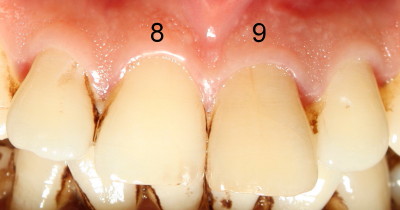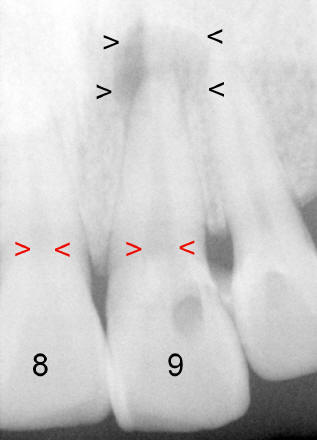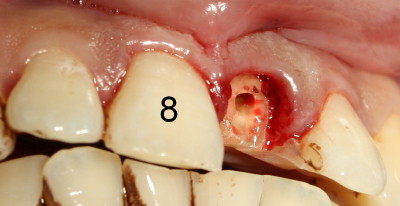


 |
 |
| Fig.1 | |
 |
|
| Fig.3 | Fig.2 |
Dental Education Lecture: After Tooth Injury
Mr. Cui is 36 years old. One of his front teeth is quite yellow and dark (#9 in Fig.1). At close-up view, there is a crack line across the tooth (Fig.1 magnification). He is afraid of pain and has never seen a dentist for any kind of dental care. His oral hygiene is not so good: there is a lot of stain between the teeth. One day, he accidentally bit on a spoon. The yellow tooth was broken (Fig.3). The tooth was extracted.
Why does this tooth turn yellow? Why is it so brittle?
When he was nine years old, he had an injury to the tooth #9. It was quite loose. But gradually it got well by itself. Mr. Cui has never sought dental treatment.
After trauma, the nerve inside our front teeth gradually becomes dead. The affected teeth turn yellow and because of lack of nutrition, the tooth become quite brittle. Besides, when our adult tooth has just come out, it has a very larger nerve in the middle of the tooth. The wall of a young tooth is quite thin. The tooth is more easily to break on external force. As we grow old, the nerve becomes smaller if it is not dead and the tooth becomes stronger. When the nerve is dying or dead, the nerve remains quite large even though we keep getting old. Let us compare the size of the nerve of the teeth #8 (non-traumatic) and #9 (traumatized before) of Mr. Cui (indicated by red arrowheads in Fig.2). A sign of dead nerve of the tooth #9 is root tip infection (black arrowheads in Fig.2). The infection causes discomfort for Mr. Cui. This must be the reason that he used a spoon to play with the tooth. Unfortunately a second minor impact breaks the already weakened tooth beyond repair.
Therefore, if your kids get dental trauma, you should bring them to dental office for emergency check-up and periodic follow-up. If the nerve of the traumatized tooth is found dying, we should do root canal to prevent tooth discoloration and use white filling or crown to strengthen the tooth to avoid disaster.
Xin Wei, DDS, PhD, MS 1st edition 04/28/2010, last revision 04/30/2010